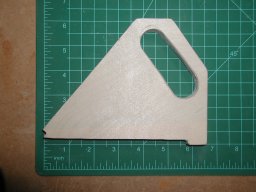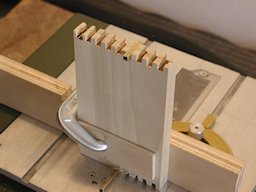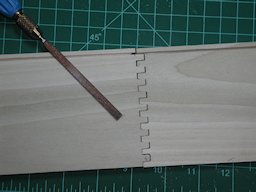| 5. Cutting the Tenons
- Extreme caution is necessary, as the blade guard is removed for this operation. Before turning on the saw, check front and back to ensure your fingers are not in the path of the blade.
- Keep a couple types of push stick close at hand. [The push stick pattern shown at that link is a bit large for these purposes. I found that scaling it down made it more usable.] There are many patterns available online.
- Practice on scrap pieces first and make some test fits before making the final pieces. I used a piece of three inch poplar cut into a few lengths of five inches for this purpose.
- I clamped two matching pieces (two sides, two endpieces) together to save time in cutting.
 |
|
- For the first cut, position the side(s) with the dadoed slot(s) towards the key.
- Inserting a small piece of key stock in the gaps helped keep the two pieces aligned after flipping them to cut the second row of tenons.
- Be sure to mark the first tenon of each piece, as suggested by the Lowe's instructions.
- Believe the instructions when they say to make the cuts slightly deeper than the width.
 |
|
|
- I was briefly confused by the fourth step in the Lowe's instructions--when starting to cut the second piece--and didn't interpret the photo correctly. This is where the virtues of practicing on scrap become obvious. The photo shown here should help clarify the placement of the pieces.
 |
|
|
- The wobble dado is, unfortunately, not precise. There will inevitably be problems with the final fit. It will be necessary to do some filing and sanding of the tenons to fit one piece to another.
- It is critical to mark each matching piece during this process, so that you will know for certain which two pieces are meant to be joined at each corner.
- I found that placing two selected pieces side-by-side initially gives a rough idea of where to begin the final sanding. A Permagrit or similar tungsten-carbide needle file is a good choice for this operation. But, do NOT remove any more material than absolutely necessary or the tenons will not meet and the purpose of making box joints (increasing the surface area to be glued) will be defeated.
 |
|
|





